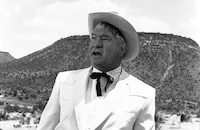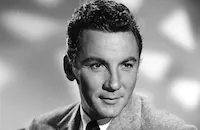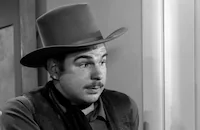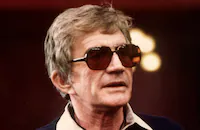What Next, Corporal Hargrove?

Brief Synopsis
Cast & Crew
Richard Thorpe
Robert Walker
Keenan Wynn
Jean Porter
Chill Wills
Hugo Haas
Film Details
Technical Specs

Synopsis
A short time after the D-Day invasion, as the Allied forces move across the Normandy peninsula toward Paris, an American unit, the B Battery of 352nd Field Artillery, becomes separated from the caravan when its artillery truck gets stuck in the mud. Unable to catch up with the caravan, Corporal Marion Hargrove, the commander of the gun crew, leads his battery to the small French town of Mardenne, which has just been liberated from the Germans. When the townspeople see Hargrove and his men approaching, they mistake them for their liberators and hail them as heroes in a huge celebration. The mayor of Mardenne, Ouidoc, extends a warm welcome to Hargrove and proudly introduces him to his attractive young daughter Jeanne. Jeanne later takes Hargrove on a private tour of the town, but Hargrove, who wishes to remain faithful to his girl friend back home, carefully resists any romantic entanglement with Jeanne. Meanwhile, another member of Hargrove's unit, Private Thomas Mulvehill, stirs up trouble by exploiting the town's hospitality and subjecting some of the residents to his confidence schemes. When the day comes for Hargrove and his men to leave Mardenne, the town sends them off with a huge farewell ceremony. Despite Hargrove's success in fostering good will between the French citizens and the Allied forces, he is later demoted for his actions and sent to work digging a garbage pit as punishment. Hargrove's fortunes soon change, however, when the Army encounters difficulties securing the trust and cooperation of the people of Mardenne, and sends his unit back to help set up a military government. Hargrove is again given a warm welcome by the townspeople, especially by Jeanne, who greets him with a big kiss. When Jeanne resumes her romantic pursuit of Hargrove, Hargrove expresses his concerns to his superiors and asks permission to tell Jeanne about his girl friend. The request is denied, however, because the Army fears that Hargrove's admission will undermine the delicate relationship between military police and the town officials. Mulvehill, meanwhile, continues to press his confidence games on the townspeople with little success. Mulvehill himself falls victim to a confidence scheme when watchmaker Marcel Vivin sells him a fake map detailing the exact location of valuable watches that are supposedly buried in a Paris cellar. When Mulvehill realizes that his unit is being forced to remain in Mardenne because of Jeanne's infatuation with Hargrove, he secretly arranges to have her leave town to join the French WACS. With their services no longer required in Mardenne, Hargrove and his division are sent to rejoin the Allied troop movement toward Paris. A short time later, while en route to the supply depot, Hargrove and Mulvehill get lost and wind up in Paris. Mulvehill insists that they look for the hidden watches, but no sooner do they start digging than they are caught by military police officers and are arrested for going AWOL. Mulvehill later wins their release by lying to the military chaplain and telling him that Hargrove left his post to see his fiancée. The plan backfires, however, when the chaplain finds Hargrove and Mulvehill consorting with Jeanne, who makes it known that she is not Hargrove's fiancée. Fed up with Mulvehill's tricks and lies, Hargrove returns to camp alone and asks to be reassigned away from him. Hargrove later has a change of heart, though, when Mulvehill fails to return to camp and is believed to be missing. After finding Mulvehill in Paris, Hargrove and Scramps return him to their unit in time to participate in a successful military offensive.

Director

Richard Thorpe
Cast

Robert Walker

Keenan Wynn

Jean Porter

Chill Wills

Hugo Haas
Wm. "bill" Phillips
Fred Essler

Cameron Mitchell
Ted Lundigan
Dick Hirbe
Arthur Walsh
Maurice Marks

Paul Langton

James Davis
John Carlyle

Walter Sande
Theodore Newton
Robert Kent

Matt Willis
Richard Bailey
John Wald
Clarence Straight
Brooks Hunt
Cliff Powell
Tex Taylor
Larry Thompson
Jack Shea
Henry Vroom
Dean Cornell
William "bill" Hall
Dick Wessel
George Backus
Ralph Brooke
Eddie Hall

Blake Edwards
Terry Mason
Harlan Miller
Bob Pepper
George Turner
Charles Faber
Walter Rode
Peter Michael
John Kellogg
Charles Murray Jr.
Riley Hill
George Kitchell

Douglas Fowley
Charles Latorre
Marek Windheim
Frank Marlowe
Ray Saxon
John James
Joe Haworth
Rune Hultman
Peter Helmers
Ben Moselle
Jon Gilbreath
Lennie Bremen
Mel Schubert
Crane Whitley
Bill Hunter
Anne O'neal
Helyn Eby-rock

Tim Murdock
Andre Charlot
Martha Baumattre
George Davis
Adrienne D'ambricourt
Crew
Albert Akst
Mark Davis
James Z. Flaster
Cedric Gibbons
A. Arnold Gillespie
Keogh Gleason
George Haight
Danny Hall
Irene
Al Jennings
Lowell S. Kinsall
Harry Kurnitz
Standish J. Lambert
Carey Loftin
M. J. Maclaughlin
Warren Newcombe
George Richelavie
Henry Sharp
Douglas Shearer
Robert W. Shirley
Harkness Smith
David Snell
Newell Sparks
Herbert Stahlberg
William Steinkamp
Michael Steinore
Richard L. Tryon Captain Field Artillery, A.u.s.
Leonid Vasian
Keith Weeks
John A. Williams
Edwin B. Willis
Paul Wrangell

Film Details
Technical Specs

Award Nominations
Best Writing, Screenplay
Articles
What Next, Corporal Hargrove? - What's Next, Corporal Hargrove?
A native New Yorker and former reporter, Kurnitz (1908-1968) wrote his first screenplay, Fast Company, based on his own book, in 1938. He was a prolific screenwriter who also wrote novels and such successful plays as A Shot in the Dark and Once More, With Feeling. He was a co-writer on Billy Wilder's adaptation of Agatha Christie's Witness for the Prosecution (1957) and was nominated for a Writers Guild Award for the William Wyler comedy How to Steal a Million (1966).
Robert Walker, whose lanky frame, spaniel eyes and comic sense made him the perfect sad-sack soldier, had emerged as a star at age 26 in See Here, Private Hargrove. He returned for the sequel, along with Keenan Wynn as his wheeler-dealer buddy Private Mulvehill. While the original film covered the bumbling pair's misadventures in boot camp, What Next, Corporal Hargrove? follows the boys as they serve in an artillery unit in wartime France (as recreated on MGM's back lot). Chill Wills is again on duty as Hargrove's nemesis, Sergeant Cramp, but Jean Porter steps into Donna Reed's shoes as the romantic interest. Future lower-rung stars Cameron Mitchell, Ted Lundigan and Jim Davis are also in the cast.
Between the two Hargrove films, Walker had solidified his star status with sensitive performances in David O. Selznick's Since You Went Away (1944), playing opposite his wife, Jennifer Jones; and MGM's The Clock (1945), with Judy Garland. But the period also saw the end of Walker's marriage to Jones, who subsequently married producer Selznick, and the actor's slide into self-destructive behavior. Although he continued acting in a dozen or so films and was particularly effective in Alfred Hitchcock's Strangers on a Train (1951), Walker's behavior became increasingly erratic. He died suddenly in 1951 after doctors gave him sedatives to calm an emotional outburst.
After the success of the films bearing his name, Hargrove (1919-2003) became a screenwriter, creating scripts for both feature films and such TV shows as Maverick, Fantasy Island and The Waltons. He won a Writers Guild of America award for his screenplay for The Music Man (1962).
Producer: George Haight
Director: Richard Thorpe
Screenplay: Harry Kurnitz, based on the characters by Marion Hargrove
Cinematography: Henry Sharp
Editing: Albert Akst
Original Music: David Snell
Art Direction: Cedric Gibbons, Leonid Vasian
Costume Design: Irene
Cast: Robert Walker (Cpl. Marion Hargrove), Keenan Wynn (Pvt. Thomas Mulvehill), Jean Porter (Jeanne Quidoc), Chill Wills (Sgt. Cramp), Hugo Haas (Mayor Quidoc), William "Bill" Phillips (Bill Burk).
BW-95m. Closed captioning.
by Roger Fristoe

What Next, Corporal Hargrove? - What's Next, Corporal Hargrove?
Quotes
Trivia
Notes
This film was a sequel to the 1943 M-G-M film See Here, Private Hargrove, which also starred Robert Walker in the title role and Keenan Wynn as "Private Thomas Mulvehill." A July 1945 Hollywood Reporter news item noted that M-G-M paid $100,000 to Sgt. Marion Hargrove for the use of his name in this film. An August 1945 Hollywood Reporter news item listed Army veterans John Saunders and Alfred Reisman in the cast, but their appearance in the released film has not been confirmed. Some filming took place at Camp Pendleton, CA. For his work on the film, Harry Kurnitz received an Academy Award nomination in the Writing (Original Story) category.

Miscellaneous Notes
Released in United States November 1945
Released in United States November 1945














